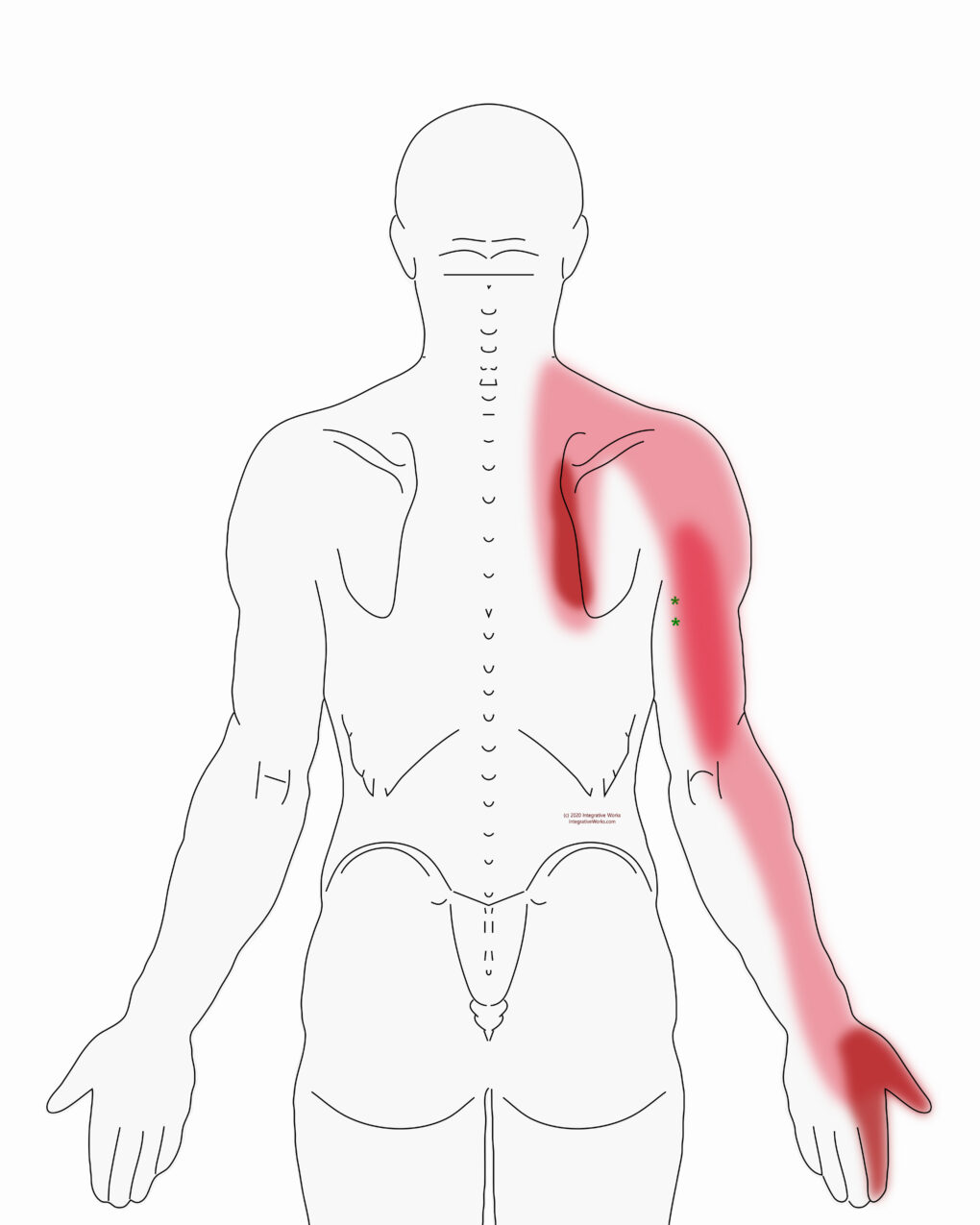Pain in the upper back, index finger, and thumb
Table of Contents
- How People Describe This Pain Pattern
- How You Activate and Intensify This Pain Pattern
- Self-Care – Getting Relief on Your Own
- Musculoskeletal Anatomy Behind Your Pain
- Therapy Notes for Massage and Bodywork
How People Describe This Pain Pattern


Pain around Thumb Pad
People complain about pain just inside the shoulder blade, thumb, and index finger. Notably, it doesn’t always create pain in the hand; sometimes, it tingles like it is “falling asleep” or “going numb.” Sometimes, they have pain or tingling when reaching out with the hands near shoulder level, like when you’re driving or cutting hair.
Often Appears in Parts
The pattern rarely occurs completely, as illustrated. But this pain along the shoulder blade and in the hand is most common. As the illustration indicates, the pain, tingling, and “numbing” is most likely to occur in the areas of darkest red.
Commonly, when there are stiff, swollen hands, the sensations around the index finger and thumb are a greater focus. However, the tension behind the shoulder is often there. However, if I press into this muscle at the base of the neck, the client describes the sensation between the shoulder blades and down the arm.
How You Activate and Intensify This Pain Pattern
Forward Head while Seated
The most common cases that I see for this involve people that sit with their shoulders forward so that it is difficult to breathe with their diaphragm. The scalenes go from being assistive breathing muscles to being the primary respiratory muscles as they lift the upper ribs and collarbone to inhale. They get overworked, displace the upper ribs, and create chronic trigger point activity.
When they identify an activity, it usually involves sitting with their hands up in front of them. This might be when they are driving with their arms at 10 & 2, working while slumped forward, rowing, or doing an activity that creates heavy breathing.
Other Symptoms
Another common report is that their arms go to sleep when they sleep on their back. Tight scalene muscles choke the neurovascular bundle that runs to your arms.
These muscles also assist with heavy breathing when sprinting or climbing stairs. People with this problem complain of tingling in their hands while huffing and puffing. This can also be a sign of thoracic outlet syndrome.
The Musculoskeletal Anatomy Behind Your Pain
Musculoskeletal Anatomy
This post on anatomy contains standard information about the origin, insertion, function, and innervation of muscles. Additionally, it includes information on functional considerations and anomalies.
Find Related Posts
Anatomy posts have a grid of all related posts. This includes posts on pain patterns, self-care, therapy notes, NMT protocols, cranial techniques, and cases.
Getting Relief on Your Own
Clinically Proven
Self-Care Strategies
Self-Care Posts have common sections to make them easy to follow and understand:
- Activities to Avoid or Change
- Strategies for Quick Relief
- Stretches and Exercise for Longer-Lasting Relief
- Yoga Corner
Therapy Notes for Massage and Bodywork
Better Bodywork
Through Shared Expertise
Therapy Notes provide details for cranial, spinal, and local joint work. These notes also link to a traditional neuromuscular protocol.
By treating integrative components first, direct work on the muscle becomes less intense while providing longer-lasting relief.
Support Integrative Works to
stay independent
and produce great content.
You can subscribe to our community on Patreon. You will get links to free content and access to exclusive content not seen on this site. In addition, we will be posting anatomy illustrations, treatment notes, and sections from our manuals not found on this site. Thank you so much for being so supportive.
Cranio Cradle Cup
This mug has classic, colorful illustrations of the craniosacral system and vault hold #3. It makes a great gift and conversation piece.